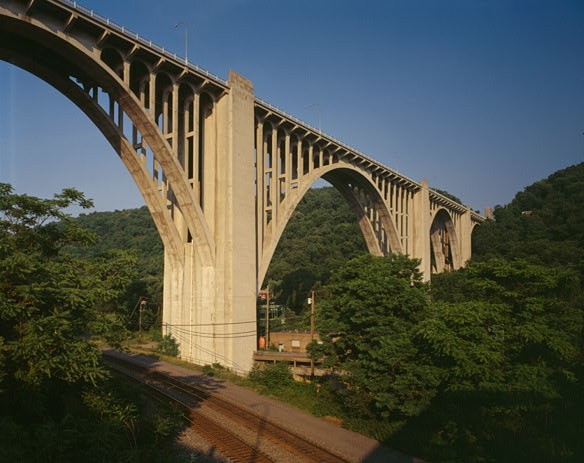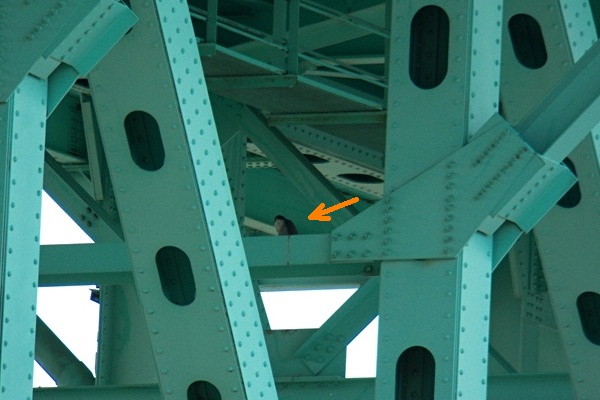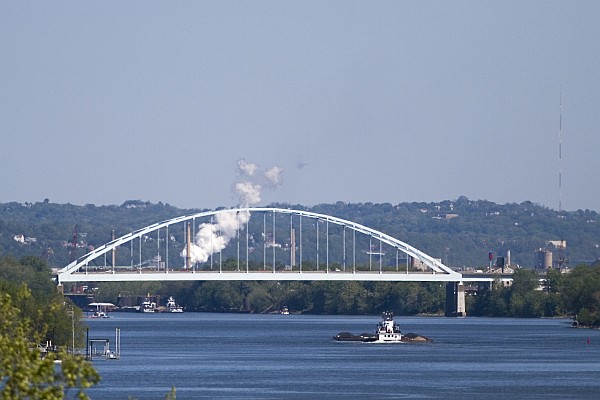Peregrine season isn’t over yet. Not only do we have two peregrine families on buildings but we now have five (5!) active sites on Pittsburgh area bridges. Four nests are confirmed, the fifth is very likely.
Here’s a roundup of bridge news beginning with our newest site, then traveling upstream. The PA Game Commission appreciates peregrine watchers at all the sites, especially at this newest one.
Neville Island I-79 Bridge (also called the Glenfield Bridge) over the Ohio River, Glenfield-to-Neville-Island (photo by Robert Strovers on Wikimedia Commons)
New! For five years peregrines have been seen near the I-79 Neville Island Bridge but this month they gave themselves away. On June 9 a peregrine fledgling was rescued from the Ohio River below the bridge and sent to a rehabber. Art McMorris, the PA Game Commission’s Peregrine Coordinator, needs your help monitoring this site. If you go: The peregrines favor the Neville Island end of the main span. Best views might be from the marina on the Glenfield side. Please report findings on PABIRDS or leave a comment here and I’ll send you Art’s contact information.

Monaca East Rochester Bridge over the Ohio River, US Route 51, Monaca-to-East-Rochester. (screenshot from timesonline.com video)
Peregrine falcons have been monitored at this bridge since 2007. This year three males and one female chick were banded on May 22. They fledged in early June and can often be seen perched on the power-towers on either side of the river. Click on the photo to see an old video of the 2008 banding from Beaver County Times Online.
.

McKees Rocks Bridge over the Ohio River at McKees Rocks. (photo by Robert Strovers, Wikimedia Commons)
Joe Fedor first noticed peregrines at this bridge in 2008. Since then they’ve been here every year. Sometimes their nest is found, sometimes not. This June 1 the Game Commission confirmed their nest by finding a feathered chick too old to band. The McKees Rocks Bridge is so large that it’s hard to see the peregrines unless they perch somewhere else — such as on the power tower near Alcosan.

Westinghouse Bridge over Turtle Creek valley, US Route 30 at East Pittsburgh. (historic photo by Joseph Elliott, Library of Congress)
Peregrine chicks were first banded at this bridge in 2010. This year the Game Commission confirmed a nest with four eggs on June 1. That’s late for eggs in Pennsylvania but it may be because there’s a new adult female here. (She hatched at the Ironton-Russell Bridge in Ironton, Ohio in 2009.) Was there a territorial dispute and a new nesting attempt? We’ll know more by early July when the Game Commission re-checks the nest.

Tarentum Bridge, PA Route 366 over the Allegheny River at Tarentum. (photo by Sharon Leadbitter)
Present since 2010, this is the first year a peregrine nest has been confirmed. Two chicks fledged early this week and the entire family has been putting on a show since then. Yesterday Sharon Leadbitter watched them flying low over the river and snapped this photo of an adult perched on the super-structure.
Right now Tarentum is the most fun to watch. Neville Island I-79 is most in need of watchers.
(photo credits above. Click on each image to see its original)
p.s. I forgot to mention 40th Street Bridge over the Allegheny River. Peregrines have been seen there. Check it out!

I heard a rumor yesterday about peregrines on the 40th st bridge … true? Should I watch there as well?
Don’t know if it’s true but I heard from Art that that bridge needs watchers!
Wow – great news for the species! And just when we thought watching season was over, the Westinghouse Bridge site extends the excitement!
Kate – You mention that some chicks are “too old to band”. Is this because of difficulty or problems catching them or some other reason?
If the chicks have flight feathers they may leap from the nest in fear before they’re able to fly. This means death for the chick so the banders don’t even attempt to band under those circumstances.
Isn’t the 40th St. Bridge in Dorothy’s and E2’s territory? It’s awfully close to St. Augustine’s (Our Lady of the Angels, where the two of them (and Henry until he moved on) hang out occasionally for easy meals.
Actually, come to think of it, the Pitt peregrines are probably hanging out at the 40th St Bridge because it’s an easy trip from St. Augustine’s to the river.
Kate the Westinghouse Bridge is near me. Where do you think the best viewing might be?
Hey, forgot to tell you that last Friday after I stopped at Gilda’s Club to drop off a book, I was leaving just before 3 PM and a raptor (I think a peregrine) scattered pigeons off the roof at Noftz Sheet Metal at Penn and 28th. I had been walking up 28th from Smallman toward Penn, and I turned around behind me and saw the peregrine (it was big) flying low toward the river on a slight angle toward the 31st Bridge. There were small white pigeon feathers floating down from everywhere, but I’m not sure if there was a hit made on the pigeons. I didn’t think the peregrine had anything in its talons.
Westinghouse has no “good” viewing spot. I did try S. Main off Bessemer Ave. in E. Pgh. this afternoon. It takes you down under the bridge. But it is railroad property. Not posted, no one chased me off, but I got some odd looks. Didn’t see any peregrines. You end up under 3 bridges and the view was rather cluttered :-/
I’ll be at COL tonight 6 – 8 and Tarentum tomorrow around 10 a.m. 🙂
Pitt COL was good at lunchtime today. We saw all 3 kids whine at Dorothy and then E2. The parents are doing fly-by deliveries and then leaving the area. For a while Dorothy perched with her back to the kids. It barely worked.
Thanks John…..I was hoping there was somewhere to view them. Well maybe I’ll get lucky just driving over the bridge.
Kate, Check CMNH Falcon forum Tower East thread….Henry was spotted!
Love your blog….. Your knowledge is outstanding!
Chad
Have you been following the Harrisburg falcons at all? The mother there disappeared around the time the babies fledged, and now there is a new female in the nest. She has already dug a new scrape, and has been engaging in pair-bonding activities with the male. Does this mean we’re going to get a second round of baby falcons this year in Harrisburg? Or is it too late for that?
I visited the Tarentum Bridge at 2:45pm on Sat June 16: Two juvenile peregrines were perched on the upstream navigation-light beam. The mother peregrine was in a cubbyhole in the bridge structure looking for pigeons/prey. She didn’t find anything. When she emerged from the cubbyhole the juvies whined. So… I saw 3 out of 4 peregrines at Tarentum. Not bad.
Carly, it is very late in the season for peregrines to start a nest in Pennsylvania. Normally they lay eggs in March so that the young have hatched in time for the big migration of songbirds in early May. Chances are very good that this pair will not nest but they will get acquainted since they will be sharing the territory and nesting next spring.
Thanks for answering my question!
The Neville Island & McKees Rocks bridges are only 3-4 miles apart as the “crow” flies. Kate, I think that you’ve written that peregrines will claim a territory with a 2-3 mile radius.
I wonder if there are occasional border wars around the eastern end of Neville Island. (I realize that there are probably not enough observers of these two sites to answer this question.)
It was an error if I said “radius.” I actually meant “distance apart.” They tend to nest about 3 miles away from each other. The Downtown and Pitt nests are just under 3 miles apart. The dividing line is not neatly at 1.5 miles because of topographic and food-supply features.
Where prey is very abundant– such as at seabird nesting cliffs — six to eight territorial pairs can nest within a single mile. (That’s approx 600 feet from each other.)
From Birds of North America Online
(peregrine: http://bna.birds.cornell.edu/bna/species/660/articles/demography)
“With radio telemetry in Colorado, Enderson and Craig (1997) estimated mean home range during nesting of 358–1,508 km2 for 2 adult males and 3 adult females. In relatively prey-rich habitat of Scotland, as little as 117 km2(Mearns 1985). In Channel Is., CA, breeders with radio transmitters foraged primarily within a 5 km of breeding cliffs (WGH); also on Queen Charlotte, I., British Columbia (Beebe 1960, Nelson 1977).”
Based off the activity I’ve noticed and from what others have told me-I’d say the 40th street bridge is very likely